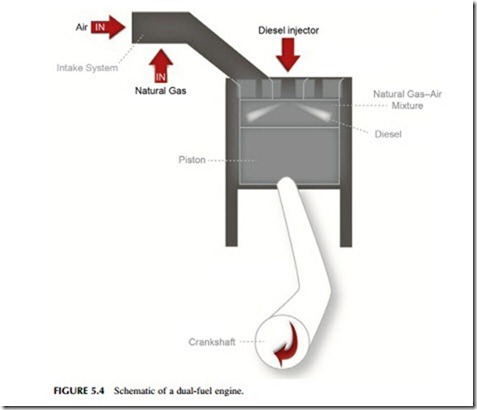DUAL-FUEL ENGINES
The large disparity in efficiency between a spark-ignition engine and a diesel engine has prompted engine developers to search for a way on achieving the efficiency of a diesel engine in a natural gas–fired spark-ignition engine. This
is the origin of the dual-fuel engine, which has been the most successful of these hybrids (Figure 5.4).
A dual-fuel engine is an engine designed to burn predominantly natural gas but with a small percentage of diesel as a pilot fuel to start ignition. The engines operate on a cross between the diesel and the Otto cycles. In operation, a natural gas–air mixture is admitted to the cylinder during the intake stroke, then com- pressed during the compression stroke. At the top of the compression stoke the pilot diesel fuel is admitted and ignites spontaneously, igniting the gas–air mixture to create the power expansion. Care has to be taken to avoid spontaneous ignition of the natural gas–air mixture, but with careful design the engine can operate at close to the compression conditions of a diesel engine, with a high- power output and high efficiency, yet with the emissions close to those of a gas- fired spark-ignition engine. However, efficiency tends to fall and emissions of unburned hydrocarbons and carbon monoxide rise at part load.
Typical dual-fuel engines operate with between 1% and 15% diesel fuel. Since a dual-fuel engine must be equipped with diesel injectors, exactly as if it were a diesel engine, a dual-fuel engine can also burn 100% diesel if necessary, though with the penalty of much higher emissions.
